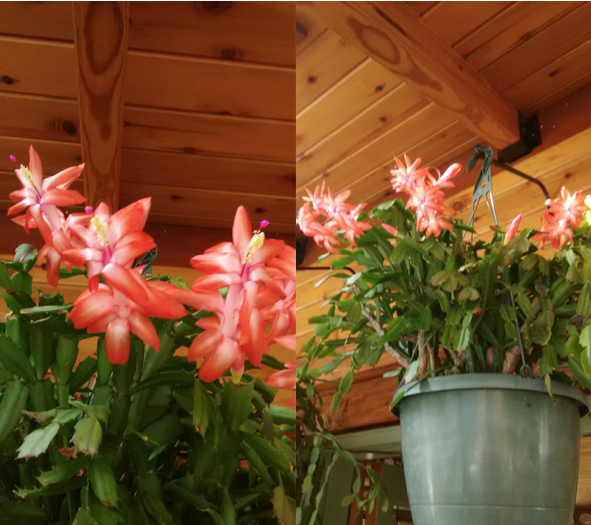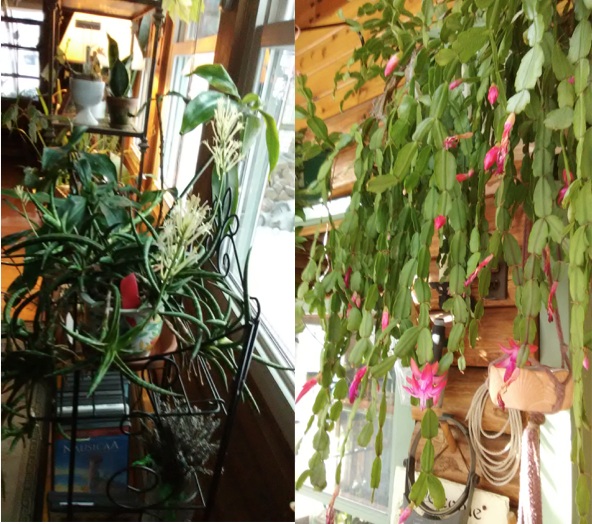Winter Care of Houseplants
By Kyle Fletcher Baker, Cumberland County Master Gardener and MCN Maine Zone 5
Well, here it is, winter in Maine and while all around us outside is usually covered with snow, some of us are tending the sporadic gardens inside. Whether it’s one or two plants or you have a virtual jungle of plants, the care during winter, is the same as for outdoor plants during the warmer weather.
With luck, you were able to move all your plants outdoors for the summer, starting them off in a sheltered, shaded spot and eventually moving the sun lovers to full morning sun for the warmer days. This helps build roots and foliage and in some cases, initiate flower production. Thanksgiving and Holiday cactii are two primary examples, that can be coaxed into bloom 2-3 times during the winter long months.
To the initiate houseplant owner, houseplants are often neglected and frequently end up being tossed in the compost pile come spring.
To get the most enjoyment out of your houseplants, you need to care for them the same as if they were outdoors in the garden. Light, soil, water and pest control are the four major areas of concern. If you can keep track of these four, then you can have luxurious, flowering and foliage plants to help combat the winter blues. Remember they’re living things, so take care of them the best you can.
It has to be stressed, that if you own a plant, or are given a plant, RESEARCH IT, as best as you can. Knowledge is a good thing to have, for if you can learn something new each day, you are ahead of the game. Knowing which plant needs a winter rest, likes evenly moist soils, likes high humidity and which can take dark rooms and cold temperatures, will make life so much easier when caring for your green friends.

Light
First and foremost this is the biggest downfall of houseplant growers. No matter how bright the light, the legginess of plants in winter is at times scary. Contrary to what I have read and been told, direct sunlight through windows in winter rarely damages plants. That isn’t to say it doesn’t happen, just that it doesn’t happen as regularly as one would be led to believe. Shade loving houseplants should be in northeast or eastern facing windows for bright or direct morning sun, and then shaded conditions for the afternoon. Sun loving houseplants should always be in southern or southwestern facing windows to receive as much afternoon sun as possible. I’ve become very attuned to the directions and have plants placed throughout the house, usually according to light, though with 150 houseplants, some end up where ever there is room.
Soil
When it comes to potting medium, gardeners often mistake this for ‘soil’. Potting medium is not soil. Soil is alive with insects, fungi, bacteria, and other living organisms. Most potting medium is man-made and quite inert. Buy organic if you can. Remember most plants will be in this ‘soil’ for somewhere between 2 – 10 years. I have epiphytic cacti that have been in the same pots for 40 – 60 years and bloom regularly every winter. If you grow tender summer bulbs like Cannas, Dahlias, Eucomis, Hedychium, Alocasias, etc., make sure you repot them at least every 2-3 years, as the root growth during their summer vacation out of doors is quite extensive.
Water
Next to light, this is the factor that kills more houseplants than any other problem. Research your plants and set up an appropriate watering schedule. Make sure that if anyone else helps out with watering, that they too know the plants well. Several years ago I lost a few Sansevierias, grown from leaf cuttings, due to my late father helping me by watering them, as he thought they looked dry. When they became waterlogged and started to collapse, he watered them more thinking they were overly dry. Within two weeks I lost at least eight, 10-year-old plants. The Sansevieria’s especially need care in watering, as they come from the arid regions of South Africa, where there is typically no more than 2-3” of rain per year. If you are not able to stick to your watering schedule, then check the plant thoroughly before watering to make sure it needs it
Pest control
Just because your plants are in pots or containers and indoors, doesn’t mean that they are immune from pest infestations. Spider mites, mealy bugs, aphids and scale are the four top pests of houseplants. Spider mites prefer dry, hot conditions and lots of light. Plectranthus (Coleus), ferns, and any other thin leaved foliage houseplants are prone to spider mite. Spider mites are highly susceptible to drowning and what can only be called pneumonia, so put the infested plant in a shower and drench it well, turning it over if necessary to get the undersides of the foliage. Aphids like lush, leafy, foliaged plants and flower spikes. They attack any orchids I have, then they move through the greenhouse looking for choice new growth to dine on. You can wash aphids off in the shower with warm water, or use insecticidal soap or horticultural oils.
Mealy bugs and scale are the hardest to get rid of, as there are usually 3 – 4 stages of insects in a colony at any given time. Eradicating them is very difficult. Mealy bugs on smaller plants can be treated with a warm shower, but for both mealy bugs and scale, I find the best approach is using insecticidal soaps sprayed on the foliage, and then wiping down both sides of the foliage with a soft but sturdy cloth. Scale, which build hard shells over themselves to protect from predation, are usually impervious to any sprays. By wiping with a cloth you can dislodge the scale and then apply a secondary spray to the foliage to get any nymph stages of the pest without protective shells.

Two houseplants that are a must!
SCHLUMBERGERAS — Claw Cactus, Christmas Cactus, Thanksgiving Cactus: Cactaceae Family
The two most common forms of Schlumbergeras grown are the Christmas cactus and claw cactus. Christmas cactus is a hybrid between two Schlumbergera species and is recognizable by its pendulous habit and soft, scalloped-edged leaf segments. Schlumbergera truncate or claw cactus, also known as the Thanksgiving cactus, is recognizable by it’s claw like leaf segments. Both are found growing as epiphytes in the jungles of Brazil, on trees or rocks in high humidity conditions. They demand filtered bright light, extremely well drained conditions and high humidity. They seem to survive in most home growing situations with no added care.
They bloom in shades of red, pink, white and rarely yellow infused. Around mid to late December is it’s bloom time, but with care they can be coaxed into bloom up to 3 – 4 times per year. They prefer high humidity, well drained roots, even moisture and steady temperatures most of the year. Dropping the temperature, outdoors or indoors, is usually what instigates flowering. I have two that have been in the same pots for roughly 30 years and are somewhere between 60 – 80 years of age. I place them outside in early spring, when all danger of frost is over, on the northeast side of the house so they get direct morning sun and then cool afternoon shade. In October I bring them indoors before the first frost and they bloom heavily in late October and December. They bloom sequentially in January and March and usually late April when I move them back outside. Fertilizing is done at ½ strength, once monthly for a 12” hanging basket. Regular watering is roughly 1cup of water each week in winter. Summer I water almost daily, as they’re so root bound that water just runs out the bottom as fast as it is applied. I’ve never encountered any pests on either of these plants.
SANSEVIERIAS — Snake Plant, Mother In Laws Tongue, Devils Tongue, Bowstring Hemp Plant: Agavaceae Family
These are usually the first plant that houseplant lovers grow. They are often neglected and seen everywhere including dark restaurants, homes, businesses and schools. Why? Because the only way to really kill one of these plants is to water it. Most novice houseplant growers make the mistake of thinking that the genus Sansevieria comes from some moist, warm, tropical rain forest and treat them as such, by watering and overwatering. The majority of the genus comes from South Africa and southern Asia, in areas that are full sun for 12 – 16 hours a day, and receive less than 10” of rain per year.
Sansevierias are easy to grow and with a little care can often be coaxed into sending up spikes of deliciously evening fragrant, white flowers. The smell is intoxicating, with a heady scent of Jasmine so strong as to be overwhelming. There is nothing so pleasant as to drift off to sleep, on a dark winter’s night, when its -10 outside and 3 feet of snow is on the ground, than a room filled with the scent of Jasmine.
The Sansevieria family has something for everyone and for every spot in the home or office. Ranging from straight upright plants that add a vertical aspect to a room, to plants that are best grown in hanging baskets, their stems spilling over the sides and cascading, akin to spider plant, to gargantuan specimens that grow 6’ tall with leaves up to 3’ wide! There are about 70 species grown with only a handful of species and their hybrids offered for sale. The most common is Sansevieria trifasciata, and its cultivar S. trifasciata var. laurentii, easily recognizable by its 3’ tall dark green leaves, margined in gold.
Place these plants outdoors in late May, when typically the last frost is done and the spring rains begin to occur on a regular basis. They will not need to be watered. The plants should NEVER sit in water for extended periods, as they will quickly succumb to rot. When given good drainage and allowed to fill a pot completely they should be worry free. In fact, repotting is usually indicated when the plants break the pot they’re in. When the plants are outside, fertilize ½ strength every week. In winter indoors, use water only, every other week. This will often reward the grower with blooms, off and on from November through April.
Pests and Diseases – Over watering leads to root rot. If the plant is suffering from rot, take a 3 -4 “ leave cutting, from any leaves that are disease and pest free, allow to dry for a day, dust the cut edge with rooting hormone and then place it in well draining cactus mix and allow to root. Water sparingly until fully established. Hand wipe the leaves of plants before bringing them in for the winter.
